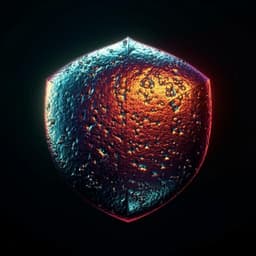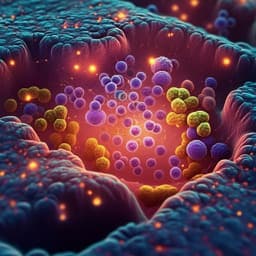
Physics
Optical force mapping at the single-nanometer scale
J. Yamanishi, H. Yamane, et al.
Explore the groundbreaking research by Junsuke Yamanishi and colleagues, showcasing the visualization of 3D photoinduced force fields around quantum dots at an unprecedented single-nanometer resolution. This vital advancement in nanophotonics can revolutionize applications in photocatalysts and optical manipulation.
~3 min • Beginner • English
Introduction
Three-dimensional distributions of photoinduced fields at or beyond the nanometre scale are essential to deduce symmetry of molecular excited states in functionalised quantum dots and complex molecular substances and to design approach paths for optical trapping. Direct visualisation of these fields at the level of individual materials is challenging due to sensitivity bottlenecks in existing techniques. The authors aim to visualise photoinduced electric field distributions on individual composite Zn–Ag–In–S (ZAIS) quantum dots at the single-nanometre scale using PiFM. They address limitations of vacuum PiFM—photothermal cantilever vibrations and modulation-frequency mismatch upon resonance shifts—by proposing a heterodyne frequency modulation (heterodyne-FM) scheme that decouples the detected signal from these artifacts, enabling sensitive, thermally stable measurements and true nanoscale 3D field mapping.
Literature Review
Prior near-field optical techniques have achieved subwavelength to angstrom-level imaging (e.g., apertureless and scanning near-field methods), but direct 3D mapping of photoinduced fields on single nanostructures remains limited by sensitivity and artifacts. PiFM detects optical gradient forces proportional to ∇|E|^2 and offers high sensitivity relative to other near-field techniques. Operating under vacuum improves cantilever force sensitivity and thermal stability and eliminates confounding water layers, but introduces photothermal vibration artifacts and modulation-frequency detuning. Earlier heterodyne approaches in PiFM mitigate photothermal effects; this work extends them with frequency modulation to track resonance shifts and enable artifact-free detection. The study also leverages discrete dipole approximation (DDA) simulations and dyadic Green’s function formalisms from the literature to interpret photoinduced forces and validate experimental observations.
Methodology
The authors implemented PiFM with a heterodyne frequency modulation (heterodyne-FM) scheme under ultra-high vacuum (~5.0×10^−7 Pa) at room temperature. The cantilever (gold-coated Si, OPUS 240AC-GG) had k≈2 N/m, first resonance f1≈44.849 kHz, Q≈35,400, and was driven with amplitude A1=10 nm in FM-AFM; tip–sample distance was controlled by the frequency shift Δf. In heterodyne-FM, the laser intensity was modulated at 2f1+fm (with fm within the PLL bandwidth for Δf detection). The photoinduced gradient force modulates Δf at fm, detected via lock-in (non-delayed X component), yielding Δf(fm)X. Since 2f1+fm is far from f1, photothermal-induced cantilever vibrations do not contaminate the signal, and as f1 shifts, the heterodyne signal frequency follows, avoiding detuning artifacts. Phase delay in the irradiation electronics was measured (photodetector rise time 1 ns) and compensated so that the detected signal is in phase with the laser modulation.
Multiple wavelengths were measured simultaneously by assigning different fm values per wavelength: modulation frequencies were set to 2f1+230 Hz (λ=520 and 785 nm) and 2f1+325 Hz (λ=660 nm). Side illumination at 70° incidence was used; the laser diode intensity was Pop≈15±15 mW. PiFM images were normalized to the response on a ~100 nm thin gold film on mica to remove spot-dependent effects. AFM images and PiFM images were acquired simultaneously, typically in constant-frequency feedback mode (Δf≈20 Hz) to maintain tip–sample distance; Fig. 2 used Δf≈−20 Hz as specified. For 3D mapping (λ=660 nm), a force curve was acquired at each pixel in feedback mode such that the closest approach z0 corresponded to Δf=−28 Hz; z0 variations across pixels were compensated post-acquisition to align the bottom plane. Noise in the 3D dataset Δf(fm)X(x,y,z) was reduced using exploratory factor analysis. The measured Δf(fm)X(z) was converted to the vertical photoinduced force Fz^pif(z) using a weight-function-based frequency-shift-to-force conversion, then integrated over z to obtain the tip–sample interaction potential U(x,y,z). Lateral photoinduced forces Fx^pif and Fy^pif were derived by taking spatial derivatives of U along x and y to construct 3D force-vector maps.
Samples were dumbbell-shaped ZAIS quantum dots (nanoellipsoids at both ends and a nanorod in the centre) dispersed on a thin gold film on mica (AU 15 M). ZAIS QDs were synthesized with distinct electronic states (~1.97 eV at ends and ~2.92 eV at the rod) and diluted in toluene to 2.906×10^−2 nM before spraying 20 μL onto the substrate. Optical modelling employed the discrete dipole approximation (DDA) to compute field and force distributions for comparison with experiments. Potential electrostatic artifacts (surface photovoltage, contact potential) were assessed: excitation at 660 and 785 nm is below bandgaps of both regions of the QD, suppressing photovoltage; van der Waals forces dominated distance control and contact potential differences were negligible, as supported by force curves.
Key Findings
- Simultaneous PiFM imaging at multiple wavelengths resolved distinct photoinduced forces on ZAIS QD components. At 660 nm (1.88 eV), the photoinduced force was strongly localized at the nanoellipsoidal ends; at 520 nm (2.38 eV), forces on the ends and rod were more comparable. Line profiles showed end/rod force ratios of ~1.88 (660 nm) and ~1.20 (520 nm); DDA simulations yielded similar ratios (~1.59 and ~1.07).
- Imaging at 660 and 785 nm both showed pronounced forces on the nanoellipsoids, consistent with DDA calculations and line-profile analyses, demonstrating nanoscale optical spectromicroscopy via gradient-force detection.
- High-resolution PiFM revealed internal nanoscale variations not visible in AFM topography; a spatial resolution of ~0.7 nm was achieved (from Δf(fm)X line profiles), representing, to the authors’ knowledge, the highest spatial resolution for linear optical near-field observations in the visible.
- 3D mapping (λ=660 nm) produced quantitative force curves: at closest approach (Δz=0), Fz^pif at the QD end was ~7 pN, approximately 10× stronger than on the gold film; attenuation lengths of the force were ~0.4 nm (QD end), ~0.8 nm (QD centre), and ~1.8 nm (gold), enabling sub-nanometre resolution.
- The interaction potential derived from Fz^pif mapped values of ~20–40 meV on the nanoellipsoids at Δz=0, reflecting the local field-intensity gradient. Lateral derivatives of the potential yielded 3D force-vector fields that, within ~10 nm of the QD, pointed toward the QD; far from the QD, directions appeared random.
- The experimental 3D force and potential maps agree well with theoretical calculations (DDA and related models) within the applicable distance regime, validating both the heterodyne-FM PiFM approach and the designed electronic structure of the QDs.
Discussion
The study addresses the challenge of directly visualising 3D photoinduced fields at single-nanometre scales by introducing heterodyne-FM PiFM under UHV, which suppresses photothermal artifacts and maintains sensitivity despite resonance shifts. The resulting 3D maps of interaction potential and force vectors quantitatively capture localized optical responses in individual ZAIS QDs, correlating with their engineered electronic structures and photocatalytic-relevant properties. The sharp attenuation lengths and strong end-localized forces enable sub-nanometre spatial resolution and suggest feasibility for resolving intra-molecular optical features. Agreement with theoretical models strengthens confidence in interpreting gradient-force-based PiFM data and supports using such maps to guide design in photocatalysis, nanophotonics, and optical manipulation (e.g., optical trapping path planning via vector fields).
Conclusion
The authors demonstrate, for the first time, 3D visualisation of photoinduced interaction potentials and force-field vectors at single-nanometre resolution using heterodyne-FM PiFM under UHV. They achieve ~0.7 nm spatial resolution and quantify forces (~7 pN at QD ends) and potentials (~20–40 meV), with results consistent with theory. The technique mitigates photothermal and resonance-shift artifacts and enables multi-wavelength, nanoscale optical spectromicroscopy. These advances open opportunities to study localized optical phenomena relevant to photocatalysis and luminescence and point to future work on observing optical responses within single molecules using low-temperature operation, sharpened tips, or higher-NA focusing for enhanced forces. The heterodyne-FM approach is also applicable in ambient and liquid environments, suggesting broad utility in chemistry and biology.
Limitations
- Experiments were conducted under UHV at room temperature on ZAIS QDs deposited on gold; performance and generalisability to other materials and environments, while promising, were not experimentally demonstrated here.
- 3D mapping was primarily reported at 660 nm; broader spectral 3D mapping was not shown.
- Theoretical comparisons (DDA and related models) agree within the distance range where the models are applicable; near-contact regimes and complex tip–sample interactions may involve approximations (e.g., tip shape, material response).
- Conversion from frequency-shift signals to force and potential relies on a weight-function model and noise reduction via exploratory factor analysis, which may introduce uncertainties not fully quantified in the main text.
Related Publications
Explore these studies to deepen your understanding of the subject.







